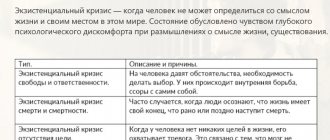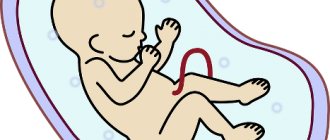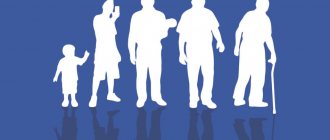- What is a crisis?
- What can cause a crisis?
- Types of crisis conditions
- The reaction of the human psyche to a stressful situation
- Goals and objectives of crisis psychology
The science of crisis psychology (psychology of crisis states) owes its emergence to the enormous number of disasters that arise in our reality. These are epidemics, terrorist attacks, man-made disasters, military operations, accidents and other difficult situations. A person, one way or another, is involved in all these incidents as an initiator, victim or witness, and the psychology of crisis situations teaches him to cope with dangerous emotional consequences. Let's talk in more detail about this direction, its goals and objectives.
What is a turning point in life?
The course of the crisis can be strong, moderate or weak. If the turning point develops unfavorably, the individual faces negative consequences that significantly complicate life:
- melancholy;
- breakdown;
- depression;
- emergence of dependencies;
- social maladjustment.
A person constantly feels dissatisfied: he is depressed, irritated for no apparent reason. Many are haunted by suicidal thoughts. In some cases, people cannot cope with a crisis without the help of a psychologist. That’s why it’s so important to pay attention to changes in your behavior and worldview.
Is it possible to overcome
How to cheer yourself up quickly when you feel bad - methods and tips
Most psychologists believe that a crisis is the most important prerequisite for personal change, the nature of which can be either positive: constructive, creative, integrative, or negative: destructive, destructive.
Important! Psychology says that you can overcome a crisis on your own, but it is better if your loved ones help. Parents can help their child. To do this, it is necessary to penetrate into the inner world of a teenager, find out what he is interested in, accept his musical preferences, clothing style, and worldview. Family and friends will help an adult facing a crisis.
Growing up crises
Scientific definition of the term
The stages of personality development are considered not only by psychology. Philosophers, biologists, representatives of the medical and pedagogical fields have their own ideas about the periodization of development. But only psychology considers this period comprehensively, covering mental, physical, and intellectual changes.
In psychology, a crisis is a state in which a person experiences stress associated with unwanted changes. His feelings, views and habits, social status change. Each stage of development allows you to gain new skills and master the necessary skills. If this does not happen, the individual gets stuck at one of the stages. He is confused, it is difficult for him to build relationships with others. The longer the crisis drags on, the lower the individual’s chances of successfully integrating into society.
Personality development according to Erikson
According to Erikson's theory, personality development goes through 8 stages. In essence, this theory suggests that personality development continues throughout life.
The transition from one stage to another is associated with specific conflicts. Having resolved which, the person moves to another stage, and in fact - to a new life stage of his development. If the conflict is not resolved, then, as you yourself understand, the individual will get stuck at the stage and will not move on to the next stage of his development.
Classification
The stages of personality development can be divided according to form and source. Crises happen:
- Neurotic - accompany age-related changes. In some cases, they are not associated with real changes and are formed by the individual himself. A person first experiences a neurotic crisis in early childhood, at the first conscious contact with other children. He feels discomfort from the realization that he is not the only child in the world, he will have to learn to interact.
- Age-related - appear in a borderline situation when the zone of proximal development becomes the zone of actual development. Having mastered new skills, the individual moves to a new stage of personality development, changing his attitude towards himself and the world. Living through changes well helps increase self-confidence, maintain relationships and create new ones. But during a protracted crisis, he loses communication skills and does not perceive himself as a full-fledged person.
- Traumatic - arise as a response to a tragic situation, negative external influence from adults or peers. Experiencing a catastrophe leads to stagnation. He stops developing, loses the ability to make decisions independently and manage his life.
Normally, critical changes occur quickly, without interfering with the normal flow of life.
About 40% of people claim that they have not experienced turning points, but in fact they were simply lucky not to encounter negative manifestations.
conclusions
Psychological crises are not just a necessity, but the most important, irreplaceable condition for the normal continuation of a person’s future life and his development. The main thing in any crisis is its outcome. Behind the negative traits of behavior during crisis periods of life is hidden the positive essence of crises, which consists in the transition to a new, qualitatively higher model of behavior. A crisis is both a driving force of development and a sharp leap in human development. Without changing his behavior, a person simply will not be able to continue further normal life and development. People grow and develop only through crises.
Symptoms of the turning point
You can notice the beginning of the crisis by the characteristic symptoms that began to appear suddenly:
- causeless feeling of anxiety, uncertainty;
- need for solitude;
- difficulties in communication;
- loss of life goals;
- panic when thinking about the future;
- desire for destructive behavior;
- aggressiveness, conflict.
The appearance of one symptom does not mean the beginning of a turning point. But the combination of signs and the corresponding age is a reason to take a closer look at your condition.
Age-related changes
Among all types of crises in psychology, age-related ones are mandatory for everyone. There are 9 main stages of personality development:
- Birth - the sudden transition of a newborn from the mother's womb into a new unfamiliar world causes great stress. The baby's psyche begins to form and respond to external factors.
- 1 year - the child learns to walk, his comfort zone expands significantly, and along with it the psycho-emotional load increases.
- 3 years - formation of primary independence. One of the most difficult stages, manifested by whims and refusal to obey adults.
- The preschool period is preparation for the transition to a new social status. The end of early childhood, the desire to take one’s place in a group of peers.
- Adolescence is the transition from childhood to adulthood, the formation of one’s own personality.
- Youth is the final stage in the formation of an adult personality, determining one’s life path.
- 30 years is a period of maturity, summing up the first results of life.
- 40 years old - awareness of the first signs of aging, regret about missed opportunities.
- 50 years - acceptance of approaching old age, preparation for the new social status of a pensioner.
At each stage, a person has to come to terms with the fact that he can no longer live as before. If the outcome is positive, he learns to apply new skills. If negative, it stops and can return to the previous stage.
Psychological crises of adults
The “quarter life crisis” is associated with graduating from school, university or college, separation from parents, entering a “real” independent life, the need to find a job, choose a permanent sexual partner and create a family, have children and provide for loved ones.
At this stage, a person realizes that “real” life without parents turns out to be not at all as easy (“rosy”) as it seemed at school and student age. The main contradiction of the quarter-life crisis is the contradiction between ideas about adult life at school and college age and “real” life itself.
The main contradiction of the “crisis of 30 years” is associated with the assessment of what has been achieved and planned and the efforts expended. At this stage of development, a person begins to adjust his plans, goals and objectives.
Midlife crisis is the most famous psychological crisis. A midlife crisis is associated with the fact that a person realizes that life has not turned out at all as a person planned in childhood, adolescence and young adulthood, that expectations, desires and dreams have not been fulfilled. It often happens that if there is still a desire to radically change your life, then there is no strength and opportunity for this, and, conversely, if there are still opportunities and strength to radically change your life, then the desire is no longer there. This is due to both subjective (decreased physical activity and stress) and objective biological reasons. Among the latter reasons are the gradual aging of the body, a decrease in the level of metabolism, a decrease in hormonal levels, an objective decrease in endurance and other physical qualities. External signs of this are the appearance of fat folds, the appearance of wrinkles, and baldness. These external signs further intensify the manifestations of a midlife crisis. A person begins to realize that youth and youthful strength are irretrievably gone, that one’s own old age and death are not some distant phenomenon, but very real and, most importantly, inevitable facts.
Another feature of this psychological crisis is related to the fact that his children leave home and go into independent life. A person begins to feel inner emptiness and loneliness. Despite the decrease in external attractiveness and demand from the opposite sex, a person begins to look for connections on the side and cheat on his spouse.
The main contradiction of the midlife crisis (midlife crisis) is the contradiction between the idea of life and its planning in childhood, adolescence and young adulthood and the real life of a person, the real state of affairs.
A turning point in men
If for women turning points are associated with the loss of beauty and attractiveness, for men they are tied to the feeling of physical strength and sexual activity. A man, accustomed to an active life, realizes that his youth has passed; he no longer arouses such interest among women. Relationships with my wife have long become familiar and routine; they no longer provide new emotions and impressions.
At the age of 40, many men start relationships with young lovers. The admiration of a young girl is a source of strengthening male self-esteem. But if a man has already begun to have health problems, he no longer feels complete, and the crisis becomes more complicated.
Men who have realized themselves in a career or hobby are able to get out of it safely - social success becomes a substitute for physical strength.
Theory and practice of psychology of crisis situations 4462
In the modern world, there are more and more problems caused by the adverse consequences of human activity. These are issues related not only to the ecology of the habitat, but also to the complication and aggravation of social conflicts at the level of the individual, family, team, state and interstate relations. The variety of social conflicts accompanied by violence and cruelty (local military conflicts, terrorism, criminal situations, etc.), severe natural disasters (natural disasters) and man-made disasters further aggravate human existence than it was in the last century.
These universal crisis factors in our country are combined with the specifics of its development. In the last two decades, the pace of life of Russians has accelerated significantly. Socio-economic disadvantage, a decrease in living standards, and the loss of habitual, stereotypical values and attitudes by almost all segments of the population have caused a massive increase in tension, manifested in an increase in the level of general anxiety, an increase in such experiences as loneliness, uselessness, meaninglessness of existence, uncertainty, fear for the future and much more. In this regard, in medicine, psychology, and sociology, more and more researchers are capturing the problem field, designated as “crisis” (from the Greek crisis - decision, turning point, outcome). The essence of the concept of crisis is very accurately conveyed by the Chinese in two characters, one of which means “danger” and the other “opportunity”.
The problem of the crisis of individual life developed mainly within the framework of preventive psychiatry. As synonyms for the term “crisis” in psychological literature, the concepts of “critical period” (T. Shibutani), “turning point”, “transition” (G. Sheehy), “turning stage of life’s path” (S. L. Rubinstein), “ gap" (L. S. Vygotsky), "critical situation" (F. E. Vasilyuk).
The theory of crises was formed on the basis of the theory of evolution, the theory of achievement and growth of human motivation, the theory of adaptation in the modern refraction of the concepts of emergency and extreme situations. There is also an influence of psychoanalysis on the theory of crises.
The basic ones were studies of various reactions to life crises in minor psychiatry by L. Lindemann (1944), psychological and psychophysiological studies of stress, stages of development of distress by G. Selye (1956), the concept of eight life cycles and the corresponding psychosocial crises of E. Erikson (1959), concepts of three types of crises by V. V. Kozlov (1997).
There are at least two characteristic aspects of crisis theory. The first is that it concerns the individual, although some of its concepts are used in relation to the family, small and large groups. Secondly, a crisis is not only possible pathological consequences, but also an opportunity for personal growth and development. Thus, having absorbed previous theoretical views and practical research, crisis theory has formed a new psychological discipline - the psychology of crisis situations.
The relevance of developing the topic of personality crisis is dictated by the high probability of completion of the crisis by the most pronounced socio-psychological disadaptation of the individual, leading to desocialization, marginality, radicalism, fanaticism, totalitarianism, destructiveness, even suicide. However, if adaptive resources are available and timely assistance is received, a transition to a new, higher level of personality development and individualization is possible.
The essence of the nature of personality crises is characterized by the following features.
- A crisis is, first of all, a violation of the internal balance (mental, emotional, emotional) or homeostasis of a person, resulting from environmental influences.
- Any crisis is a turning point in personal development. Depending on which path (constructive or destructive) the individual begins to develop further, his entire future life will take shape.
- A crisis does not arise on its own; it is a consequence of the subjective ideational and sensory perception of various kinds of social, natural and economic influences or situations that violate habitual life patterns and create an obstacle, causing experiences or actions when a person is not able to resolve them on his own.
It should be emphasized that in the course of life, any person faces a crisis. At a minimum, these are age-related crises, crises of interpersonal relationships or family dramas. Among the events that can lead to a crisis, researchers identify such as the death of a loved one, serious illness, separation from parents, family, friends, change in appearance, change in social situation, starting a family, sudden changes in social status, etc. Theoretically, life events are qualified as leading to a crisis if they “create a potential or actual threat to the satisfaction of basic needs...” [6, p. 28] and at the same time they pose a problem to the individual, “from which he cannot escape and which he cannot solve using the methods of adaptation available in his experience” [ibid.].
Thus, we can talk about the inevitability of experiencing crises by any person as a necessary moment in life, the process of individualization, the socio-psychological process of development and formation of the individual and the group. In essence, a crisis is a crisis of life
, a critical moment and turning point in life's journey. As V.V. Kozlov notes, a crisis is always a moment of choice from several possible alternatives, a moment of choosing a regressive or progressive solution in further development [2, p. 10]. He defines a crisis as a natural (age and existential crisis) or artificial (anthropogenic, technogenic, sociogenic) obstacle on the path of life, which is impossible for an individual or group to overcome with the usual resources [ibid., p. 8].
If we already know the content of the concept of “crisis,” then the concept of “situation” requires disclosure.
Based on the analysis of the problem of personal-situational interaction, N. G. Osukhova proposes to give the following definition of a situation: a situation is a segment of the life path, a system of objective and subjective elements (external and internal conditions) that are combined in a person’s life at one time or another life [6, p. 9].
It has become generally accepted that a person’s behavior is determined not by an objectively existing situation, but by a subjectively experienced situation, such as it exists for him (H. Heckhausen). T. Shibutani determined that “a person’s behavior depends not so much on the objective as on the subjective aspect of the situation - on how the person himself defines this situation” [9, p. 166−167].
Summarizing the results of the analysis of the views of various authors on the connection between personality and situation, N. G. Osukhova [6, p. 17] draws conclusions:
- human behavior in a life situation (including difficult ones) is the result of the interaction of external and internal conditions;
- to characterize the process of a person going through difficult extreme situations and experiencing the crises that arise in connection with this means to determine what exactly happens between these two sides, “external” and “internal” conditions, to find the personal structures through which a person establishes and regulates this balance, and both in situations of everyday, everyday life, and in complex, problematic, difficult, and even extreme situations of your life.
In the normal cycle of life, a person constantly faces unpleasant situations in ordinary (everyday) business, educational, and family life. It was precisely this term (daily hissles - everyday troubles) that R. Lazarus introduced to refer to such situations back in the 1970s. This concept implicitly contains the idea of the need to highlight the level of complexity of difficult situations.
The question of a difficult life situation for a person arises when changes in the environment external to a person disrupt the relative balance of external and internal conditions of life (adaptation to life) or threaten to disrupt his activities, relationships with significant people, and his usual way of life in in general or in one of the living spaces, thereby creating a potential or actual threat to existence and the satisfaction of basic life needs. N. G. Osukhova considers this characteristic of a difficult life situation to be basic [6, p. 29].
Restoring lost balance may require a person to engage in activity directed outward (considerable effort, energy expenditure), or serious changes in the inner world - transformation of oneself. Moreover, the result of all these efforts is unclear (a situation of uncertainty).
From a psychological point of view
, according to N.G. Osukhova [ibid.],
a difficult life situation
can be called a situation in which, as a result of external influences or internal changes, a person’s adaptation to life is disrupted, as a result of which he is unable to satisfy his basic life needs through models and methods of activity (behavior) developed in previous periods of life.
Not only is a person’s usual relationship with the world disrupted, but it becomes impossible to adapt to these changes without serious work in the external or internal world. All difficult life situations are characterized by a violation of the stability of the usual way of life
(in one or another space of existence) and
the emergence of the need for change.
N. G. Osukhova defines a critical situation as a situation of impossibility
, i.e. a situation in which the subject is faced with the impossibility of realizing the internal
necessity
of his life (motives, aspirations, values, etc.).
Both V.V. Kozlov and N.G. Osukhova, in our opinion, most accurately identified the essential characteristics of the psychology of crisis situations. In view of the ambiguous views of various researchers on the genesis and classification of crisis conditions, we propose to take as a basis a single criterion established by modern legislation.
The definition of the concept of “difficult life situation” is presented in the Federal Law “On the Fundamentals of Social Services for the Population”, adopted by the State Duma of the Russian Federation on December 10, 1995 No. 195 (Article 3). In it, a difficult life situation is understood as a situation that objectively disrupts the life of a citizen (disability, inability to self-care due to old age, illness, orphanhood, neglect, poverty, unemployment, lack of a specific place of residence, conflicts and abuse in the family, loneliness, etc.) . p.), which he cannot overcome on his own. That is, the criterion is the impossibility of overcoming a life obstacle with familiar resources or, in other words, a violation of adaptation to life.
Of the characteristic features listed by both researchers and legislation, the key ones, in our opinion, are: violation of habitual life stereotypes, which create an obstacle (“impossibility”) and cause experiences or actions when a person is not able to resolve them on his own.
The main goal of the psychology of crisis situations is to study the reasons for the formation and development of changes in a person’s mental activity, taking into account his personal characteristics under the influence of subjectively threatening or total external environmental influences, with the subsequent implementation of the practical needs of the individual or social (professional) groups of the population in short-term and accessible psychological ( psychocorrectional) assistance. At the same time, both subjectively significant and objective psychotraumatic external environmental influences not only determine the need for psychological help, but also often entail legal consequences. The main parameters that determine the main types of critical situations and their differences are the external and internal conditions of a person’s life, the type of his activity and the specificity of the vital necessity that is blocked and creates the “impossibility” of further life activity.
To correlate the content of crisis and stress, we present the stages of stress development described by G.I. Kositsky [2, p. 193].
- Initially, there is a stage of mobilization, accompanied by increased attention and activity. This is a normal, working stage. Loads, even frequent ones, occurring at this stage, lead to training the body, increasing its resistance to stress - a primary increase in tension, stimulating habitual ways of solving problems;
- The second stage of stress, or the “phase of sthenic negative emotion,” which is sthenic, active in nature: rage, anger, aggression. The body's resources are spent uneconomically. Repeated exercise leads to exhaustion;
- The phase of “asthenic negative emotion”. There comes a turn of negative emotions that are asthenic, passive, powerless, and decadent in nature. A person is overcome by melancholy, despair, and disbelief in the possibility of getting out of a difficult situation;
- The last stage is neurosis, breakdown. The person becomes demoralized and resigns himself to defeat. The negative consequences that stress leaves in the body occur: depression, the initial stages of psychosomatic illness.
The last three stages, in fact, represent the zone of crisis of the individual.
Some researchers [6, p. 36] there are two types of crisis situations
, differing in the degree of possibility they leave for the realization of the internal necessity of life.
Crisis of the first
kind can seriously hinder and complicate the implementation of life plans, but with it there is still the possibility of restoring the course of life interrupted by the crisis. This is a test from which a person can emerge having essentially preserved his life plan and confirmed his self-identity.
The situation of the second
kind of, the crisis itself makes the implementation of life’s plans impossible. The result of experiencing this impossibility is the metamorphosis of the personality, its rebirth, the adoption of a new life plan, new values, a new life strategy, a new self-image.
This division can be challenged, since the “crisis of the first kind” does not correspond to the leading features - there is no “impossibility” of resolving problems independently.
In modern crisis theory, the following basic concepts of crisis situations are distinguished [2, p. 9].
Personal crisis
− this is a psychological state of maximum disintegration (at the intrapsychic level) and maladaptation (at the socio-psychological level) of the individual, expressed in the loss of basic life guidelines (values, basic motivation, behavioral patterns), arising as a result of obstacles in the usual course of the subject’s life.
Crisis state
− this is a personal crisis prolonged over time.
Crisis personality
- a subject who, as a result of post-crisis negative disintegration, becomes a carrier of deviant or delinquent behavior, a neuropsychic or psychosomatic disorder as personality traits, a method of adaptation to the social environment.
Vulnerability level
– the ability to expect (or avoid) a disaster, limit its impact, the ability to cope with it, and also recover from its consequences [6, p. 71].
Situations leading to a certain crisis state are traditionally divided into:
- to stressful events (traumas, disasters, wars, loss of loved ones, etc.), provoking various types of crisis reactions (acute reaction to stress up to reactive psychosis), delayed reaction to stress from two months to one year (post-traumatic stress disorder) and super delayed reaction to stress (shock trauma);
- transition to the next age level (age crises);
- transition to a new stage of personal transformation (existential crises).
A crisis is one of the inevitable and necessary moments of life, one of the driving forces of development, including the development of an individual, group, and society. Consequently, a crisis is a necessary part of the life of an individual and society, of humanity as a whole as an organism; a crisis is always a moment of choice from several possible alternatives, a moment of choosing a regressive or progressive solution in further development.
A crisis is always disintegration, but it offers two options - positive, when a person increases the level of his integrity, or negative, when he becomes a pain for himself and for society. The entire subsequent life of the individual depends on what choice is made.
For better understanding and detail, all personal crises can be divided into two main categories.
Internal crises
– age-related, life and existential (i.e. crises caused by the natural development of personality).
External crises
− external traumatic events act as stressors in them - extreme crisis situations that have a powerful negative consequence, life-threatening situations for oneself or significant loved ones. These situations affect the human psyche, causing traumatic stress, the psychological consequences of which are expressed in post-traumatic stress disorder (PTSD), which occurs as a protracted or delayed reaction to situations involving a serious threat to life and health. According to ICD-10, these crisis situations cause the following personality reactions:
- acute reactions to stress, where the stress factor is a certain event in life that poses a direct threat to a person’s life (war, attack, disaster, rape, etc.). Acute reactions to stress include crisis conditions, acute crisis reaction, combat fatigue;
- shock trauma - mental shock, a delayed painful reaction to shock trauma manifests itself several years later in the form of maladaptive behavior or psychosomatic illness;
- post-traumatic stress disorder (PTSD) is a delayed or prolonged reaction to experiencing traumatic stress.
In foreign and domestic studies of PTSD, the main attention was paid to veterans of the Vietnam War (work of American psychologists), in Afghanistan and Chechnya (Russian psychologists). What happens to a person experiencing trauma? How can one carry out his psychological rehabilitation and social readaptation? These questions were central to the research.
Currently, PTSD is increasingly used in relation to the consequences of peacetime disasters, as data have been obtained indicating the clinical and pathogenetic unity of these conditions. The classification of the most common causes in peacetime involves the identification of the following psychotraumatic factors: natural (climatic, seismic), environmental and man-made disasters; fires; terrorist actions (they are systematic in Russia); sexual violence; presence at the violent death of others in the event of a robbery; accidents, including transport and industrial accidents; family dramas.
Of course, emphasis must be placed on the most numerous traumatic situations. Thus, according to the Russian Ministry of Emergency Situations, in 2008, 2,154 emergencies occurred on the territory of the Russian Federation. Of these, 1966 emergencies were man-made in nature. At the same time, 4455 people died, 2176 were injured. Natural emergencies amounted to only 162 cases, 21 people died, 1249 were injured. In 2007, the figures were more serious. The number of victims, that is, those in need of medical and psychological assistance, amounted to 27,335 people. This is 27 thousand 335 human destinies!
The latest events at the end of 2009 (the terrorist attack on the Nevsky Express) and the beginning of 2010 - the earthquake in Haiti (over 170 thousand people died) confirm the multifactorial nature of the causes of crisis situations. The consequences of the total disaster in Haiti required the mobilization of forces to provide humanitarian assistance to the entire world community.
According to estimates by W. Pecora, director of the US Geological Survey, between three and five million people have died from earthquakes and volcanic eruptions over the last thousand years. The summary data on the strongest earthquakes in the world in the 20th century provides information on more than 340, including catastrophic ones, accompanied by large human casualties.
Researchers who have studied the frequency of mental disorders observed during earthquakes come to the conclusion that, at the time of exposure, acute reactive psychoses occur in 10-25% of the affected population. The number of people who are diagnosed with mental disorders at subsequent stages of development of the situation varies widely: from 3 to 35% of the affected population. Thus, it was revealed that within a year after the earthquake in Managua, the number of hospitalizations in psychiatric hospitals doubled; The incidence of neuroses has increased significantly (and significantly). Neurotic and psychosomatic disorders associated with the disaster have been observed in victims for a number of years.
The psychology of crisis situations occupies a special place in the organization of a system of medical and psychological support for the activities of law enforcement officers whose professional (official) activities are of an extreme nature. In addition to the potential vital threat arising as a result of an armed confrontation with antisocial elements, a fire confrontation with an armed criminal or group is characterized by such conditions as excessiveness (excessiveness, extreme unusualness) and the extent of external environmental influences, including the frequency or frequency of employees’ participation in them. An example is the performance of service and combat missions to ensure law and order and public safety in the North Caucasus region (NCR). At the same time, such a characteristic of the labor process is noted as a sudden change in life and professional stereotype (new conditions of life support), which in a certain part of people can cause a violation of psychological adaptation.
The qualitative component of the tension in the work (service) activities of employees reflects the load primarily on the central nervous system, sensory organs and emotional sphere of the employee. With excessive or prolonged psycho-emotional stress that exceeds the barrier of mental stability, the adaptive stress reaction becomes pathogenic, manifested in the disorganization of the psychosocial and psychobiological functions of the individual. The resulting states of mental maladjustment are manifested in decreased performance, increased fatigue, abnormal personal reactions, deviant forms of behavior (alcohol abuse, suicidal tendencies, aggressiveness, impulsiveness of actions, etc.), neuropsychic and psychosomatic (hypertension, coronary heart disease , gastric ulcer, bronchial asthma, skin diseases, etc.) disorders.
Of course, in addition to the specifics of their professional activities, police officers are also affected by general external environmental factors and social living conditions, which adversely affect the health indicators of Russian citizens. These include:
- socio-economic factors (low material security, alcoholism, smoking, drug addiction, etc.);
- low level of health education of the population and promotion of a healthy lifestyle, which leads to low commitment of the population to a healthy lifestyle;
- poor financing of the system and a low regulatory and legal framework for healthcare, which results in a low level of material and technical base, and, consequently, low motivation of personnel for quality work, etc.
The combination of the characteristics of professional activity and general unfavorable conditions further complicates the task of protecting the mental health of police officers.
Constant psycho-emotional tension is a significant deforming factor in the professional and socio-psychological activities of employees.
Professional deformation (PD) is a change in the professional capabilities and personality of an employee in an asocial direction, arising as a result of negative features of the organization, content and conditions of professional activity. The extreme degree is professional degradation, when violation of the law, immorality, antisocial behavior or professional impotence makes further service impossible. Research has shown that PD before 5 years of service is unlikely; 6−10 years - average probability, 11−15 years high probability, over 15 years - inevitable.
Our studies have shown that the prevalence of psychogenic reactions and conditions have a clear correlation with the length of stay in the North Caucasus region [4].
Concluding the topic of patterns in the prevalence of mental disorders among employees, we should point out the direct correlation between the decrease in the success of the service and mental morbidity.
The analysis showed that in the group of employees with mental disorders the number of unsuccessful employees almost triples and the number of successful ones decreases. This indicates not only an unfavorable tendency for the generation of predominantly borderline mental disorders among employees, but also the ability of the service to change, to a certain extent, the general structure of the personality due to secondary acquired forms of behavior in connection with constant communication with offenders and work in extreme conditions. Therefore, during the service, the number of so-called accentuated personalities statistically significantly increases, i.e., a certain personal “sharpening” occurs, the protrusion of some personal traits at the expense of the suppression of others.
Mental and physical overload and extreme factors caused by the specifics of the professional activities of law enforcement officers determine the need for a new model for organizing medical and psychological preventive measures.
It seems to us that from the standpoint of rationally increasing the effectiveness of health protection measures, preventive psycho-hygienic and treatment and rehabilitation work, it is necessary to identify priority categories of people who, first of all and without fail, must undergo planned diagnostic and rehabilitation measures. The scope of examinations and the provision of medical and psychological care should be differentiated, i.e. determined depending on the category of those examined, the time allocated, the degree and severity of extreme exposures suffered, etc. Such a systematic approach will make it possible to rationally distribute and use material and financial costs, which is especially important in conditions of underfunding of departmental health care.
Taking into account modern views on the psychology of crisis situations, for the rational and targeted organization of preventive psychodiagnostic examinations and rehabilitation medical and psychological measures in the internal affairs department, the following priority categories of employees of internal affairs bodies can be identified.
First
is caused by stress factors specific to work activities, which are characterized by a high probability of anthropogenic – extreme impacts. It can be divided into three groups.
A
. Employees of special (riot police, special forces) and operational units. The professional and social stress factors and their possible consequences are constant stressors that create emotional tension in the majority of employees with a feeling of danger to life - professional activity of an extreme nature, causing a high risk of stress disorders and conditions, psychosomatic diseases and neurological disorders. mental disorders.
B
.
Employees who took part in counter-terrorism operations (armed conflicts) in the North Caucasus region - stressors of periodic action
in extreme conditions - episodes of super-strong psychotraumatic effects (death of friends, the sight of corpses, being ambushed or surrounded, sudden shelling, the use of military weapons, the first murder enemy, crossing minefields, etc.); unusual climatic and geographical conditions, lack of water and quality food, chronic fatigue, decreased tolerance to psychogenic stress.
A high risk of stress-related neuropsychiatric disorders and psychosomatic diseases is assumed.
IN
.
Employees who took part in extreme situations (fire contacts) or in ensuring public order during the liquidation of the consequences of emergency situations are periodic stressors
with a high probability of developing stress-related disorders, psychosomatic diseases with the threat of auto- and hetero-aggression.
Second
, caused by stress factors of living conditions - difficult life situations, which can also be divided into three groups.
A
. Employees with pronounced social problems: lack of normal living conditions, loneliness, large families, low income are constant stressors. Chronic absence of normal living conditions, leading to the formation of a neurotic type of reaction (neurotic reactions and states), personality disorders with the threat of auto- and hetero-aggression.
B.
Employees who are in a difficult life situation (death of loved ones or serious illness of loved ones, divorce, etc.) are at risk of developing neurotic reactions and conditions, personality disorders with the threat of auto- and hetero-aggression.
IN.
Employees going through a mid-life age crisis (40 years old) are at risk of developing neurotic reactions and conditions, personality disorders with the threat of auto- and hetero-aggression, due to dissatisfaction with the level of career growth, marital relationships, etc.
Third,
caused by stress factors of health problems or personal characteristics that complicate professional adaptation, which can be divided into two groups.
A
. Employees who are often and long-term ill are chronic psychophysical ill-being, leading to neurotic or personality disorders with the risk of auto-aggressive behavior.
B
. Employees exhibiting conflicting forms of behavior - conflicts associated with social behavior (intrapersonal, interpersonal, objective, asocial), including the threat of criminal liability, being under investigation; fear of shame, self-condemnation for an unseemly act. In these cases, there is a high probability of developing situational reactions in the form of a reaction of emotional imbalance; pessimistic situational reaction; negative balance reactions; demobilization reactions; opposition reactions; reactions of disorganization; neurotic reactions and conditions, personality disorders with the threat of heteroaggression (autoaggression).
Fourth
caused by stress factors of mastering new types of activities or the volume of professional and service activities, also includes two groups.
A.
Employees appointed to management positions of operational command staff are stress factors of adaptation stress: increased responsibility, a new scope of official powers and responsibilities. The risk of developing conflicting forms of social behavior, heteroaggression (autoaggression).
B
. Employees assigned, based on the results of professional selection, to the group of in-depth psychological attention - a history of risk factors that complicate professional adaptation.
When planning preventive examinations, it is necessary, in our opinion, to take into account the length of service of employees, the increase of which (see above) increases the likelihood of unstable reactions that turn into psychosomatic reactions, as well as professional deformation.
For each category, it is necessary to provide for the frequency of preventive examinations, taking into account the risk of possible health problems and the prevention of professional deformation.
Until now, when addressing issues of organizing medical and psychological care, we have to use the Torres strategy [8] - the “screening” (sifting) strategy, according to which, during diagnostic measures, deviations from normative behavior or stress reactions and conditions are identified and measures are taken to combat them. This approach may take place in conditions of examination of large groups of employees, limited time or insufficient level of resource and material and technical capabilities of medical institutions and psychological units. However, in employees who did not have “risk factors” as part of screening examinations, deviations in their health status may be detected.
For effective medical and psychological support for employees of internal affairs bodies and their socio-psychological rehabilitation, it is necessary:
- organize a “Helpline” service - since the specifics of the internal affairs department cause employees to fear that if individual problems are disclosed, difficulties will arise with further service;
- determine the optimal timing for business trips to “hot spots”, since the length of stay correlates with the prevalence of psychogenic disorders;
- improve methods for diagnosing mental and functional disorders;
- carry out routine examinations of personnel taking into account the above four categories;
- take measures to increase the number of specialized preventive measures at the level of psychotherapy rooms, psychological relief, specialized rehabilitation units (centers), sanatoriums, departmental clinics and hospitals;
- pay as much attention as possible to working with the families of employees who performed operational and official tasks in extreme conditions.
Relationship problems
The psychology of relationships marks turning points that affect the way lovers perceive each other. The most difficult stage a couple faces is the end of “romantic” love. The relationship turns into a calmer form, lovers begin to notice all each other’s shortcomings. This period begins 3 years after the start of the novel. Lovers often quarrel and do not want to seek a compromise. Many couples break up. The post-wedding stage and the birth of the first child are also difficult to experience.










